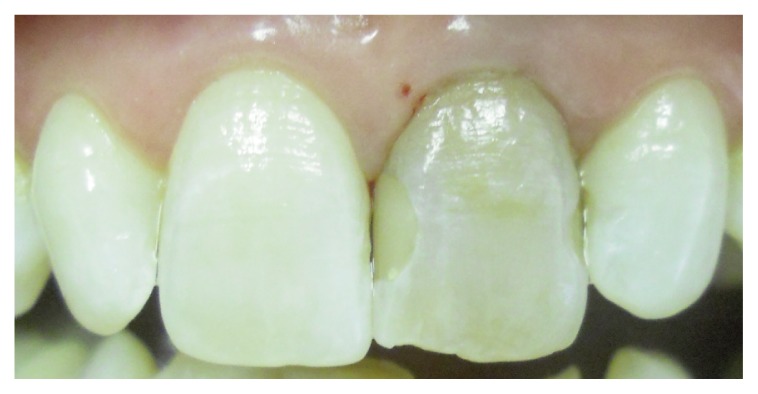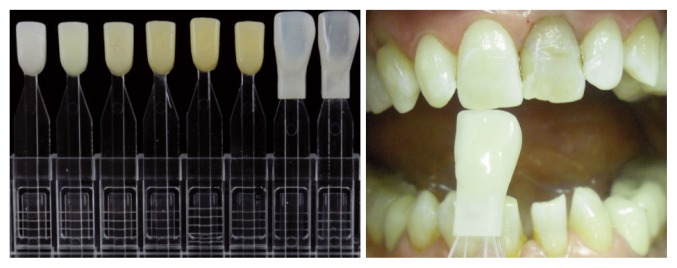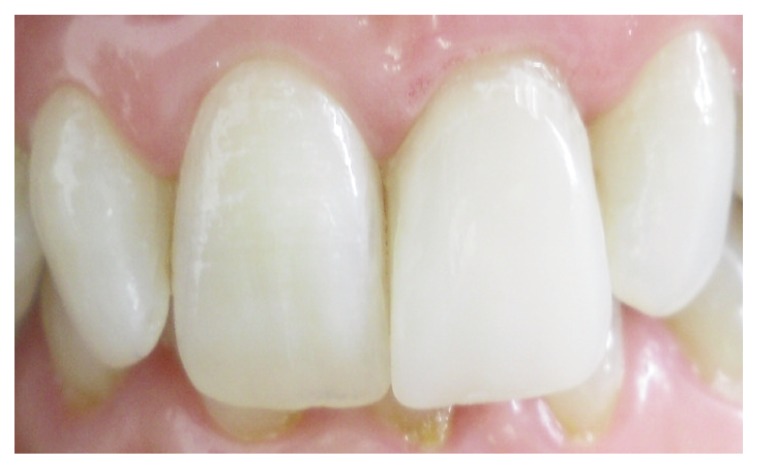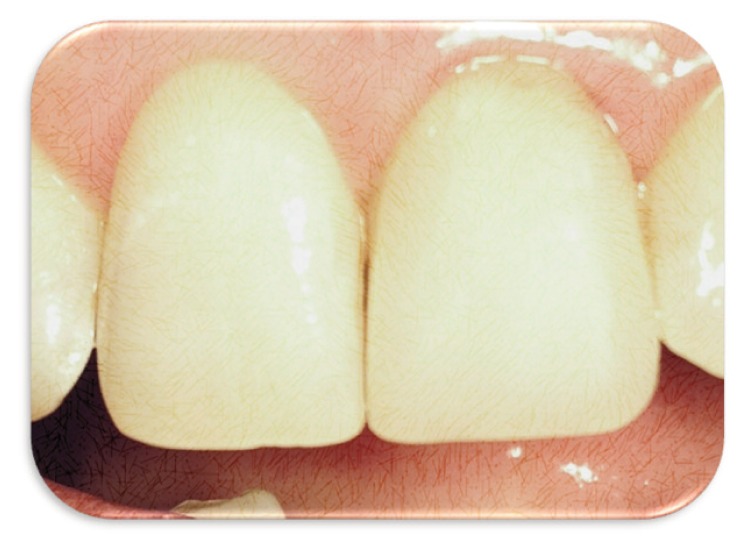Summary
Aim
Re-establishing a patient’s lost dental aesthetic appearance is one of the most important topics for contemporary dentistry. New treatment materials and methods have been coming on the scene, day by day, in order to achieve such an aim. Most dentists prefer more conservative and aesthetic approaches, such as direct or indirect veneer restorations, instead of full-ceramic crowns for anteriors where aesthetics is really important.
The aim of the study is to evaluate clinically the effectiveness of a direct composite veneering system in resolving aesthetic problem of an upper incisor with a multidisciplinary treatment approach.
Methods
Patient with a severe discolored upper incisor came to our attention; at the X-ray exam there was an evidence of a past not good root canal treatment and also old and incongruent composite obturation. After removing all the material inside the root canal was performed a new correct endodontic filling, then Authors tried to bleach the tooth trough “walking-bleach” technique with a hydrogen peroxide (30 volumes) and sodium perborate solution without excellent results. So it was decided to insert a glass-fiber post and than to perform a direct composite veneer with Componeer System (Coltene). Componeer System is a system of prefabricated composite veneers that are abled to be applied directly in the first appointment: after a conservative preparation of the tooth, it must be used an adhesive agent (for example a “three steps”) and then with composite stratification it’s possible to apply the componeer veneer (choosing the right measure, modified as necessary) as the last covering aesthetic layer.
Result
The evaluation of result of this multidisciplinary treatment was essentially clinical and radiological; in fact it’s possible to observe, from a clinical point of view, the good aesthetic aspect of the direct composite restoration with componeer veneer that offers also some advantages: conservative preparation with minimal lost of tooth tissue, easy standardized technique, low cost and immediate restoration of the tooth (without provisional passage). From a radiological point of view it’s possible to check the good quality of endodontic retreatment on the post-operative periapical X-ray. To verify the long-term result Authors consider follow up at six months and one year.
Conclusion
A multidisciplinary approach is always necessary to program a treatment plan in dentistry; in the case reported Authors decide to perform an endo-conservative treatment with different steps:
- root canal therapy to resolve endodontical problem
- glass fiber post to reinforce the conservative restoration
- direct composite veneer restoration (after bleaching) to obtain the resolution of anterior aesthetic problems.
Keywords: restorative dentistry, componeer
Introduction
Increasing demands for aesthetic restorative treatments and recent advances in adhesive dentistry have led to the development of materials and techniques aimed at restoring the natural tooth appearance, especially in the anterior segment.
Anterior tooth discoloration is one of the most frequent causes of dental treatment. In the past years, dentists had been using several techniques and materials, such as resin and porcelain to correct aesthetic problems caused by various clinical conditions. Porcelain and other all-ceramic veneers are rated as the best veneer restorations (1–3) for discolored or malformed anterior teeth. Veneers have evolved over the last several decades becoming one of the most popular restoration tools in aesthetic dentistry. The veneer is considered as an alterative to full coverage and enhances the aesthetic appearance of the anterior dentition. Veneers can be divided into 3 categories: 1) free-hand layering with direct composite resins; 2) preformed acrylic laminates; 3) laboratory-fabricated veneers (acrylic resins, composite resins, porcelains, and glass ceramic veneers) (4–6). Excellent results can be achieved with the modern advanced composite resin and adhesive systems; in contrast to conservative restorations they are able to correct existing abnormalities, aesthetic deficiencies (fractured, malformed or malposed teeth), and discolorations where it is difficult to recreate harmonious tooth shape and color. Disadvantages of the direct composite veneers include long term color changing, less wear resistance, which means that they often require repair or replacement, whereas disadvantages of ceramic veneers include irreversible removal of tooth structure, technique sensitivity, cost and length of time needed from the initial stage of tooth preparation until the restoration is finally seated (7).
The tooth can be discolored by deposition of pigments in its internal structure and on its surface (Tab. 1) (8). Importantly, the accurate diagnosis of discoloration is a condition with multifactorial etiology; it is classified as extrinsic and intrinsic and can occur due to a number of metabolic diseases, systemic conditions and local factors (Tab. 2) (9).
Table 1.
Causes of tooth discoloration and types of stains.
| Intrinsic discoloration | Extrinsic discoloration | Internalized discoloration | Types of stains |
|---|---|---|---|
| 1. Alkaptonuria | 1. Metallic | 1. Developmental defects | 1. Brown stain |
| 2. Congenital erythropoietic porphyria | 2. Non-metallic | 2. Acquired defects | 2. Black stain |
| 3. Congenital hyperbilirubinaemia | a) Tooth wear and gingival recession | 3. Orange stain | |
| 4. Amelogenesis imperfect | b) Dental caries | 4. Green stain | |
| 5. Dentinogenesis imperfect | c) Restorative materials (Manuel et al., 2010) | 5. Metallic stain | |
| 6. Tetracycline staining | 6. Yellowish brown stains | ||
| 7. Fluorosis | 7. Violet to black | ||
| 8. Enamel hypoplasia | 8. Red-black | ||
| 9. Pulpal hemorrhagic products | |||
| 10. Root resorption | |||
| 11. Ageing |
Table 2.
Extrinsic and intrinsic factors and their characteristics.
| Extrinsic factors | Characteristics | Intrinsic factors | Characteristics |
|---|---|---|---|
| Chromogenic bacteria stains | Green, black-brown and orange | Dentinogenesis imperfecta | Yellow or grey-brown |
| Tobacco | Black, brown | Amelogenesis imperfecta | Yellow-brown |
| Amalgam | Black, grey | Dental fluorosis | Opaque white to yellow-brown patches |
| Medicaments | Silver-nitrate: Grey black | Sulphur drugs | Black staining |
| Stannous-fluoride: Black brown | |||
| Chlorhexidine: Black brown | |||
| Foods and beverages | Coffee, tea, wine, berries, etc.: | Tetracyclines: | |
| Color of corresponding food item | Chlortetracycline | Grey-brown hue | |
| Oxytetracycline | Brown-yellow to yellow | ||
| Tetracycline HCL | Brown-yellow to yellow | ||
| Dimethylchlortetracycline | Brown-yellow to yellow | ||
| Minocycline | Blue-grey to grey | ||
| Doxycycline | No change | ||
| Iron | Black cervical discoloration | Dental trauma | Transiently red through to black |
| Ochronosis | Brown |
Classification of tooth discoloration
Intrinsic discoloration: intrinsic discoloration occurs following a change to the structural composition or thickness of the dental hard tissues. The normal color of teeth is determined by the blue, green and pink tints of the enamel and is reinforced by the yellow through the brown shades of dentine beneath. A number of metabolic diseases and systemic factors is known to affect the developing dentition and cause discoloration as a consequence. In addition, local factors such as injury are also recognized.
Extrinsic discoloration: extrinsic color discoloration is outside the tooth substance and lies on the tooth surface or in the acquired pellicle.
Internalized discoloration: internalized discoloration is the incorporation of extrinsic stain within the tooth substance following dental development. It occurs in enamel defects and in the porous surface of exposed dentine.
Composite veneer
Several Authors have suggested the use of composite resin veneers as direct or indirect method for restoring anterior teeth instead of full-ceramic crowns which provide well-functioning and aesthetic results (10–12). Nevertheless, to date, no restorative material has been more effective than the properties of the natural dental structures themselves. Prefabricated composite resin veneers have been recently introduced (13). Specifically Componeer (Coltene, Altstatten, Switzerland) prefabricated veneers are thin composite resin shells (0.3 mm cervically and 0.6–1.0 mm to the incisal edge), made of a pre-polymerized hybrid composite resin, synergy D6 (Coltene). The veneers are cemented with the same hybrid composite resin that they are made from, which has the potential of making the complete restoration as a monoblock unit (14). These veneers can be trimmed and bonded to the tooth structure using direct hybrid composite resin. One Coat Bond (Coltene) is the dentin adhesive included in the system, which is used to bond the prefabricated composite shells to the tooth structure using an etch-and-rinse bonding strategy (15, 16). Composite veneers take on special importance in Restorative Dentistry, as they are less expensive, which makes this practice a feasible option, mostly to people with a lower income and satisfy the patient’s restorative needs and aesthetic desires (17). This case report describes a clinical case performed by means of prefabricated Composite veneers to correct a variety of generalized color defects on the upper central incisor, aimed at the aesthetic and functional reconstruction with a multidisciplinary treatment approach.
Case report
A 45-year-old female patient came to our Department with a discolored tooth, a maxillary left central incisor, which was compromising the aesthetic of her smile (Fig. 1). On elaborating the medical history of the patient, it was noted that the same tooth had been traumatized previously. The tooth has an old incongruous root canal therapy (short filling), with a broken instrument inside the canal, observed through pre-treatment X-ray (Fig. 2). Furthermore, by clinical examination the defect of an old composite obturation was evident.
Figure 1.
Preoperative view of central incisor.
Figure 2.
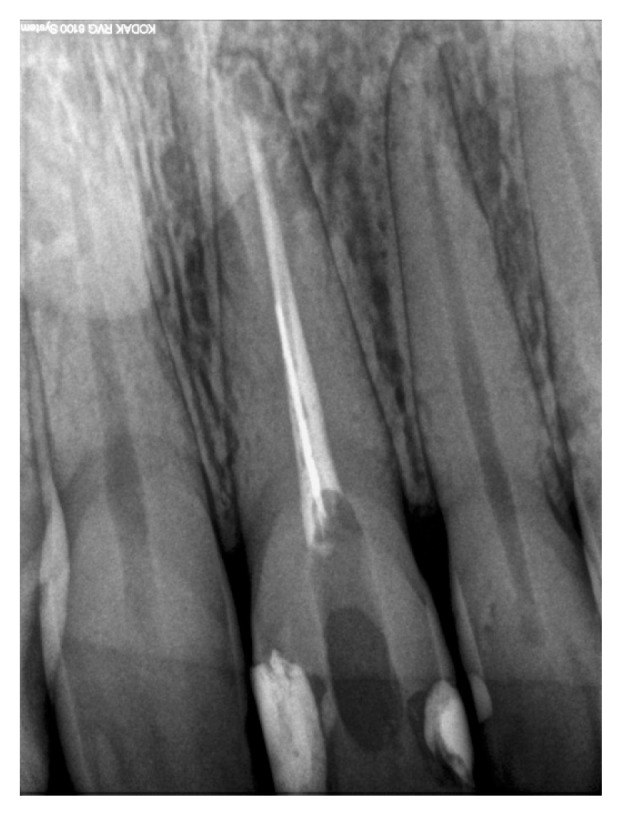
Pre-treatment X-ray.
From the above mentioned findings, in agreement with the patient, a conservative aesthetic rehabilitation was decided.
The treatment was divided into two stages:
1. Pre-restorative stage
a) Endodontic retreatment
After the anamnesis collection of data and an overall examination of oral status to exclude existing pathologies, the tooth needing retreatment was diagnosed. The diagnosis for retreatment was made according to the signs and symptoms reported by the patient and the preoperative radiographs showing apical radiolucency. The crucial factor for achieving successful retreatment is thorough reshaping and cleaning of the canals to eliminate bacteria (18–20). During retreatment the operators used bio orange solvent (OGNA) with hand K-file and ultrasonic device (Mectron) to remove the broken instrument, gutta-percha and sealer (Fig. 3). Subsequently the tooth was prepared with Mtwo (Sweden & Martina) rotary Ni-Ti instruments to working length and irrigated with 5.25% NaOCl and refilling with the Thermafil system (Dentsply; Tulsa Dental, Tulsa, OK, USA) (21) the Canal orifices were sealed with temporary material (Fig. 4).
Figure 3.

Intraoperative X-ray.
Figure 4.
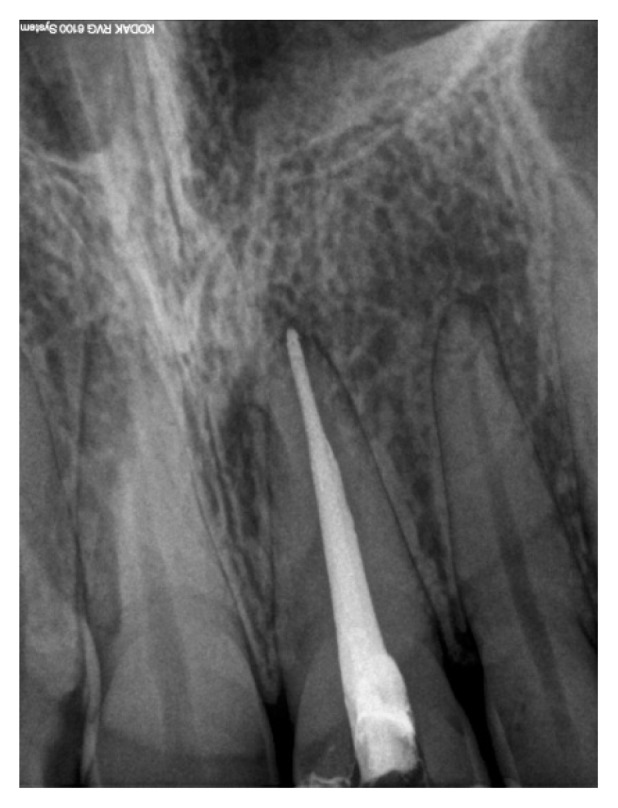
Postoperative X-ray.
b) Chemical bleaching technique
Given the appropriate indication, the bleaching of non-vital teeth is a relatively low-risk intervention to improve the aesthetics of endodontically treated teeth (22–24). Depending on the situation, the walking bleach technique can be an uncomplicated and convenient method for both patients and dentists: the bleach agent is collocated inside the pulp chamber, after putting a seal with glass-ionomeric cement at the coronal portion of the canal.
Some tooth discolorations in endodontically treated teeth are caused by dental treatments. In this case the type of root-canal filling material and medication agent, played a role in the discoloration tendency of the tooth (25).
The walking bleach technique was carried out by internal whitening treatment with an Opalescence endo (Ultradent) respectively, in the pulp chamber then using Cavit as temporary filling material to properly seal the access cavity after each operation (26–28). The procedure was repeated tree times.
2. Restorative stage
Discolored anterior teeth are often perceived as an aesthetic detraction. An array of treatment, like ceramics or composite veneering, is available for the remaining discoloration after the bleaching technique. In this case a glass-fiber posts (Sweden & Martina) was placed into the root canal to achieve retention for the restoration (29), before performing the composite veneer.
The treatment consists of prefabricated Componeer direct Composite veneering System (coltene) to enhance the aesthetics of smile (14). This technique is less traumatic and more conservative for patients with the additional advantage that it can be performed efficiently in just a single session.
a) Preparatory phase
Shade and size selection: the shade is selected with the use of the Componeer synergy D6 shade guide (Coltene). The color guide comes with six dentin cores and two enamel shells (Fig. 5). After the teeth are cleaned, the enamel and dentin shades are evaluated separately. The enamel shell guide is superimposed over the dentin core to determine the approximate final color. The size of the composite shell for a specific patient is selected with Componeer contour Guides. A wider and longer size is recommended rather than a short and narrow shape, as the clinician will have the possibility of trimming and customizing the prefabricated veneer with an abrasive disk to match the shape of the natural tooth as close as possible.
Figure 5.
Componeer synergy D6 shade guide.
b) Tooth preparation
After local anesthesia and rubber dam application, the old restoration is removed first by using a tapered-cylinder, round-end diamond bur. Tooth margins and prepared surfaces were then etched for 15 seconds with a 37% phosphoric acid etchant gel (Scotchbond Universal, 3M ESPE). The tooth were rinsed and dried, and thereafter separated by interproximal matrices. A dental bonding agent (One Coat Bond, Coltène Whaledent) was applied to all prepared surfaces, followed by gentle air-drying from the cervical to the incisal aspect and light-curing for 20 seconds. Dentin shaded composite was free-handed and then used to restore with the corresponding preparations of a conventional direct composite restoration and light-curing for 40 seconds. The size and mould required were re-checked, and the corresponding veneers adjusted. A similar layer of adhesive was applied to the bonding surface of the veneers and thereafter a thin layer of composite (Synergy D6, A1 enamel shade, Coltène Whaledent) evenly distributed with accurate marginal adaptation. The veneer was transferred to the corresponding tooth. The prefabricated veneer was pressed gently into position and shielded (without excessive pressure). While holding the veneer in position, the obvious excess was removed and the composite smoothly adapted to the Componeer with a sable brush. The entire restorative complex was then light-cured from the lingual side for at least 40 seconds, and from the facial side for 40 seconds cervically and 40 seconds incisally. Contours and occlusal interferences were adjusted with a high speed bur and margins were refined and polished by strips for interproximal areas, flexible aluminum oxide discs, which are ideal to adjust the incisal angles, and silicone rubber polishers were used for the polishing steps.
Discussion
The facial anatomical shape template in the form of a thin composite shell simplifies direct veneering of one or more front teeth. The extremely thin veneer coatings from 0.3 mm allow a high level of conservation of hard tooth substance during preparation. The shiny and naturally designed surface adds a look of vitality to the restoration.
The Componeer system is an affordable and less time consuming alternative for patients who cannot sustain the cost of porcelain veneers and presents many advantages:
minimally invasive (30);
simple and versatile application;
no impression required;
cementation using high quality permanent veneering material;
highly polished surface giving long-lasting, natural looking aesthetic clinical results (31);
shine can be refreshed by polishing at any time, unlike porcelain veneers and they can be easily repaired (31).
The other major advantage of this “different” veneering approach is straightforward solution in only one appointment with the same outcome. It has also been reported that a good quality of endodontic retreatment on the postoperative periapical X-ray (Fig. 6) may enhance the long-term aesthetic results of this method, resulting in good aesthetics, function and durability. Further investigation is needed to determine the longevity of this new treatment from six months to one year at least (Figs. 7, 8) in order to report that no failure of the restoration was detected.
Figure 6.
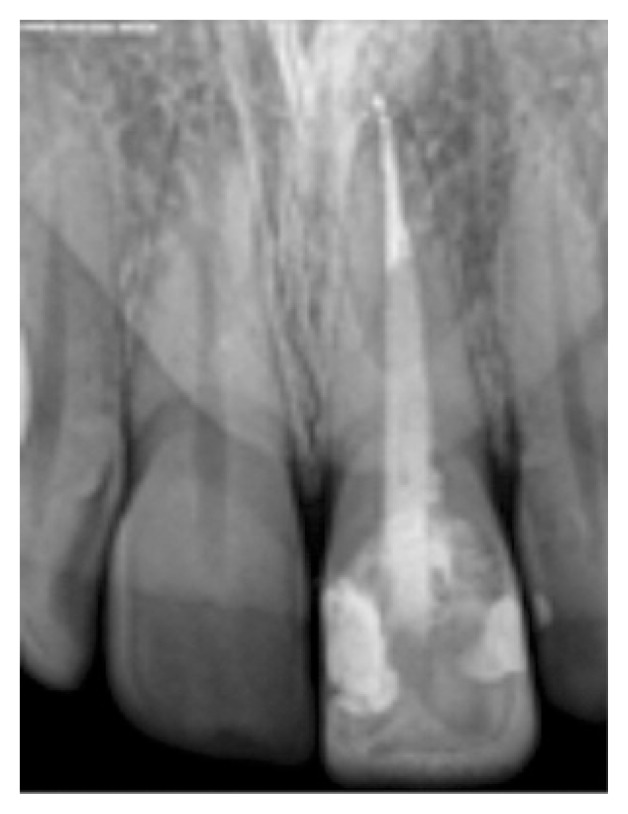
Periapical X-ray postoperative.
Figure 7.
Postoperative clinical vision.
Figure 8.
Follow up after 1 year.
Conclusion
On the basis of the results, it can be concluded that in anterior aesthetic problems it’s important to understand the etiology of the discoloration: in the case presented the corrosive products of the broken instrument inside the canal were the cause of the grey appearance of the left superior incisor. A multidisciplinary approach is to consider it necessary to resolve the problem: at first endodontic retreatment, successively bleaching and coronal restoration. To improve the aesthetic result a prefabricated adhesive composite veneer was applied. Prefabricated composite veneers are useful adjuncts to dentist armamentaria and they help in resolving aesthetic problems, in a single appointment, minimizing the dental tissue reduction.
References
- 1.Peumans M, Meerbeek BV, Lambrechts P, Vanherle G. Porcelain veneers: a review of the literature. J Dent. 2000;28:163–177. doi: 10.1016/s0300-5712(99)00066-4. [DOI] [PubMed] [Google Scholar]
- 2.Conrad HJ, Seong WJ, Pesun IJ. Current ceramic materials and systems with clinical recommendations: A systematic review. J Prosthet Dent. 2007;98:389–404. doi: 10.1016/S0022-3913(07)60124-3. [DOI] [PubMed] [Google Scholar]
- 3.Spear F, Holloway J. Which all-ceramic system is optimal for anterior esthetics? J Am Dent Assoc. 2008;139:19S–24S. doi: 10.14219/jada.archive.2008.0358. [DOI] [PubMed] [Google Scholar]
- 4.Christensen GJ. A veneering of teeth: state of the art. Dent Clin North Am. 1985;29:373–391. [PubMed] [Google Scholar]
- 5.Meijering AG, Creugers NHJ, Roters FJM, Mulder J. Survival of three types of veneer restorations in a clinical trial: a 2.5 year interim evaluation. J Dent. 1998;26:563–568. doi: 10.1016/s0300-5712(97)00032-8. [DOI] [PubMed] [Google Scholar]
- 6.Lin CY, Lee BS, Lee MS. Patients with discolored and malaligned anterior teeth able to obtain significant esthetic improvement after restoration with CAD/CAM (Cerec 3D) porcelain veneers - case report. J Dent Sci. 2006;1:88–93. [Google Scholar]
- 7.Ritter AV. Porcelain Veneers. J Esthet Restor Dent. 2002;14:55. doi: 10.1111/j.1708-8240.2002.tb00151.x. [DOI] [PubMed] [Google Scholar]
- 8.Watts A, Addy M. Tooth discoloration and staining: a review of the literature. Br Dent J. 2001;190:309–16. doi: 10.1038/sj.bdj.4800959. [DOI] [PubMed] [Google Scholar]
- 9.Sulieman M. An overview of tooth discoloration: extrinsic, intrinsic and internalized stains. Dent Update. 2005;32:463–4. 466–8, 471. doi: 10.12968/denu.2005.32.8.463. [DOI] [PubMed] [Google Scholar]
- 10.Acevedo RA, Suarez-Feito JM, Tuero CS, et al. The use of indirect composite veneers to rehabilitate patients with dental erosion: A case report. Eur J Esthet Dent. 2013;8:414–31. [PubMed] [Google Scholar]
- 11.Vanini L, De Simone F, Tammaro S. Indirect composite restorations in the anterior region: A predictable technique for complex cases. Pract Proced Aesthet Dent. 1997;9:795–802. [PubMed] [Google Scholar]
- 12.Mangani F, Cerutti A, Putignano A. Clinical approach to anterior adhesive restorations using resin composite veneers. Eur J Esthet Dent. 2007;2:188–209. [PubMed] [Google Scholar]
- 13.Dietschi D, Devigus A. Prefabricated composite veneers: Historical perspectives, indications and clinical application. Eur J Esthet Dent. 2011;6:178–87. [PubMed] [Google Scholar]
- 14.Gomes G, Perdigão J. Prefabricated Composite Resin Veneers – A Clinical Review. J Esthet Restor Dent. 2014;26:302–313. doi: 10.1111/jerd.12114. [DOI] [PubMed] [Google Scholar]
- 15.Perdigão J, Sezinando A, Muñoz MA. Prefabricated veneers-bond strengths and ultramorphological analyses. J Adhes Dent. 2014;16:137–46. doi: 10.3290/j.jad.a30689. [DOI] [PubMed] [Google Scholar]
- 16.Sahin G, Albayrak AZ, Bilgici ZS, Avci D. Synthesis and evaluation of new dental monomers with both phosphonic and carboxylic acid functional groups. J Polym Sci Part A Polym Chem. 2009;47:1953–65. [Google Scholar]
- 17.Pontons-Melo JC, Furuse AY, Mondelli J. A direct composite resin stratification technique for restoration of the smile. Quintessence Int. 2011;42:205–11. [PubMed] [Google Scholar]
- 18.Ingle JI, Bakland LK, Beveridge EE, Glick Dudley H, Hoskinson AE. Modern Endodontic Therapy. In: Ingle JI, Bakland LK, editors. Endodontics. 5th Edition. Bc Deckler; 2002. pp. 16–17. [Google Scholar]
- 19.Rocas IN, Jung IY, Lee CY, Siqueira JF., Jr Polymerase chain reaction identification of microorganisms in previously root-filled teeth in a South Korean population. J Endod. 2004;30:504–8. [PubMed] [Google Scholar]
- 20.Sjogren U, Figdor D, Persson S, Sundqvist G. Influence of infection at the time of root filling on the outcome of endodontic treatment of teeth with apical periodontitis. Int Endod J. 1997;30:297–306. doi: 10.1046/j.1365-2591.1997.00092.x. [DOI] [PubMed] [Google Scholar]
- 21.Samadi F, Jaiswal J, Saha S. A Comparative Evaluation of Efficacy of Different Obturation Techniques used in Root Canal Treatment of Anterior Teeth: An in vitro Study. Int J Clin Pediatr Dent. 2014;7:1–5. doi: 10.5005/jp-journals-10005-1224. [DOI] [PMC free article] [PubMed] [Google Scholar]
- 22.Fasanaro TS. Bleaching teeth: history, chemicals and methods used for common tooth discolorations. J Esthet Dent. 1992;4:71–78. doi: 10.1111/j.1708-8240.1992.tb00666.x. [DOI] [PubMed] [Google Scholar]
- 23.Amato M, Scaravilli MS, Farella M, Riccitiello F. Bleaching teeth treated endodontically: longterm evaluation of a case series. J Endod. 2006;32:376–378. doi: 10.1016/j.joen.2005.08.018. [DOI] [PubMed] [Google Scholar]
- 24.Marongiu N, Cochran T. Conservative cosmetic dentistry post-trauma. Gen Dent. 2014;62:26–31. [PubMed] [Google Scholar]
- 25.Krastl G, Allgayer N, Lenherr P, Filippi A. Tooth discoloration induced by endodontic materials: a literature review. Dent Traumatol. 2013;29:2–7. doi: 10.1111/j.1600-9657.2012.01141.x. [DOI] [PubMed] [Google Scholar]
- 26.Watts A, Addy M. Tooth discoloration and staining: a review of the literature. Br Dent J. 2001;190:309–16. doi: 10.1038/sj.bdj.4800959. [DOI] [PubMed] [Google Scholar]
- 27.Weisman HN. Bleaching non-vital teeth. Dental Survey. 1968;44:52–3. [PubMed] [Google Scholar]
- 28.Leendert B, Jordan RE, Skinner DH. A Conservative bleaching treatment for the non-vital discolored tooth. Compendium of Continuing Education in Dentistry. 1984;5:471–5. [PubMed] [Google Scholar]
- 29.Bandèca MC, EL-Mowafy O, Shelbl A. Nonmetallic post-endodontic restorations: A Systematic Review. Int J Dent Recife. 2010:57–62. [Google Scholar]
- 30.Furuse AY, Soares JV, Cunali RS, Gonzaga CC. Minimum intervention in restorative dentistry with V-shaped facial and palatal ceramic veneers. The Journal of Prosthetic Dentistry. 2016 Jan 7; doi: 10.1016/j.prosdent.2015.10.012. [DOI] [PubMed] [Google Scholar]
- 31.Pimentel W, Teixeira ML, Costa PP, Jorge MZ, Tiossi R. Predictable Outcomes with Porcelain Laminate Veneers: A Clinical Report. Journal of Prosthodontics. 2015 Dec 1; doi: 10.1111/jopr.12413. [DOI] [PubMed] [Google Scholar]



